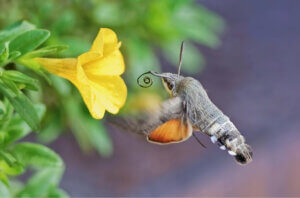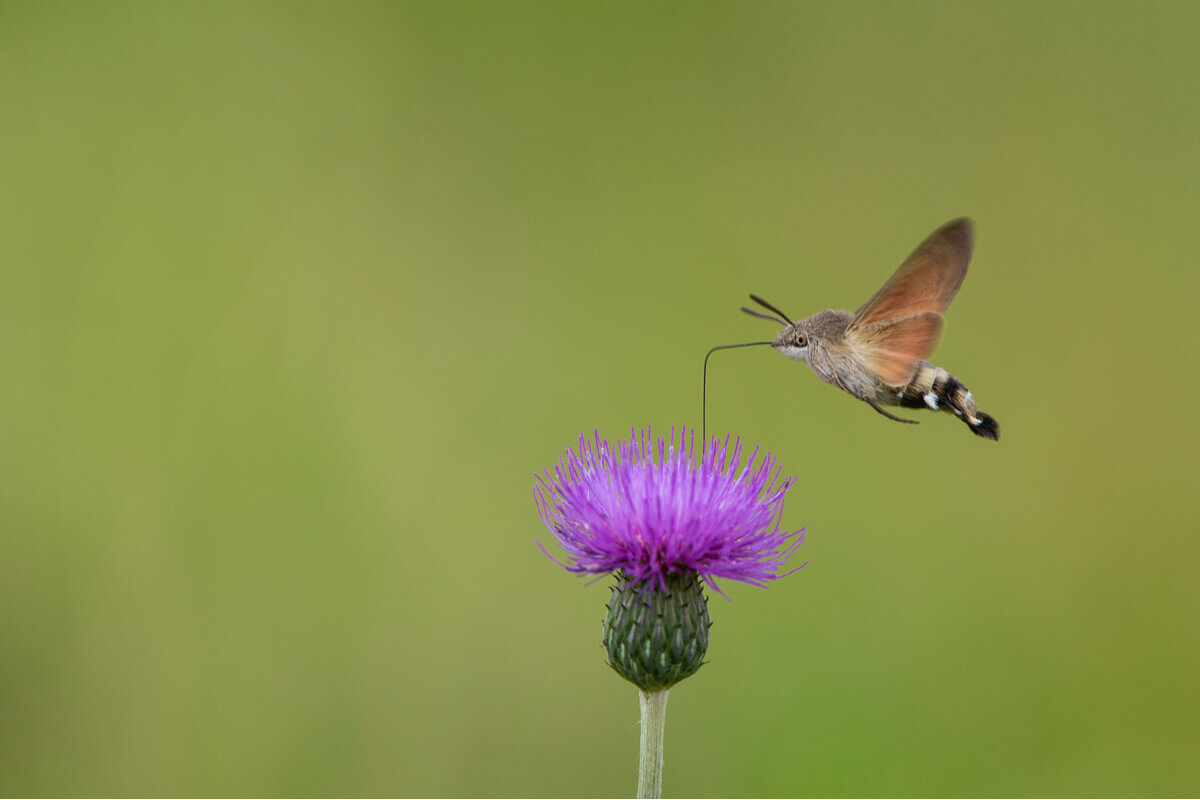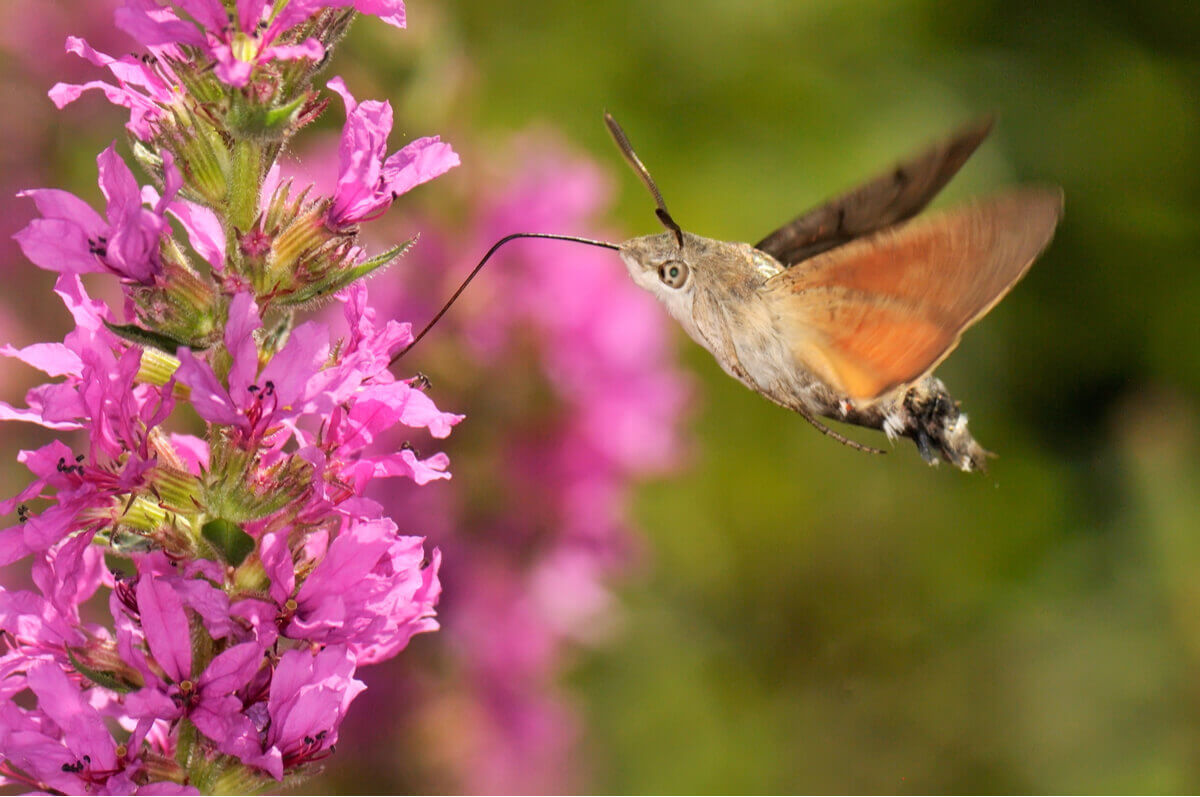The Role of the Hummingbird Hawk-moth in Pollination

The butterfly or hummingbird hawk-moth or sphynx (Macroglossum stellatarum) is a beautiful daytime moth. With its great flight control and feeding, it plays a key role in the pollination of many wild plants and orchards.
As anecdotal as this characteristic may be, it’s crucial to emphasize the essential importance of flora in our ecosystems. This is the basis of the food chain that interconnects all living beings, and therefore, the presence of pollinators in the environment that encourage their reproduction is fundamental.
A moth unlike any other
The hummingbird hawk-moth is, without a doubt, a peculiar insect. It belongs to the family of Sphingidae, a group of moths characterized by their particular rounded shape and their narrow and large wings. The name of sphinx comes from the atypical shape of its larvae, with raised heads reminiscent of this mythological figure.
Many believe this insect to be a butterfly because, contrary to other moths, it displays daytime habits. It’s common to see it grazing in the fields of southern Europe and to hear its characteristic buzzing sound. The hummingbird hawk-moth is one of the most impressive winged insects that fauna can offer us.

Bird or moth?
Although even the family to which the hummingbird belongs is particular, this species has a number of distinctive features. The most striking is its curious way of flying, reminiscent of that of a hummingbird.
Its long spirit and the speed with which it flaps its wings are very similar to those of this bird, which gives it its name. Many people have confused this curious butterfly with a bird because of its particular way of sipping flowers.
A voracious pollinator
The hummingbird hawk-moth is an excellent pollinator, very much appreciated by gardeners. Its great capacity for transport lies in the speed and control of its flight, which allows it to gather pollen from many flowers at the same time. It’s common to see it going from flower to flower in a frantic way, looking for its sweet nectar.
Likewise, these butterflies are perfectly capable of remembering which flowers they have visited and where there are groups of flowers. Because of this, it’s quite common to see the same hummingbird hawk-moth visit the same flower over a period of time.
These insects are able to remember where there are flowers with nectar at considerable distances.
A great ally for wild plants
You can find the hummingbird hawk-moth throughout practically all of Eurasia, but the specimens from the most northern areas are migratory since they can’t withstand the cold winters. According to some publications, it seems that this insect has a predilection for sage, rosemary, thistle, and verbena flowers, which are typical of the mountains and scrublands of the Mediterranean area.
It’s in this area where you’ll spot this insect more frequently, in areas that possess grass and low brush and which are free of forests.
The enormous energetic investment that the hummingbird hawk-moth spends is another factor that explains its need to pollinate many flowers. Naturally, these capacities make this moth a key factor in many ecosystems. In fact, insects, in general, are extremely important for the good health of any garden.
How to attract this insect to your garden
The great capacity and speed of pollination of this lepidopter makes it interesting to use it to pollinate the flowers of any garden or orchard. Some things that you can do to attract hummingbird hawk-moths are the following:
- Have a wide variety of colorful and eye-catching plant species for insects to want to pollinate.
- Have plants that are loaded with nectar, which is what the insects are looking for. Some of these flowers are the tulip or the sage, species that can be found in any agricultural store.
- Planting the flowers together facilitates pollination. And, of course, avoiding the use of pesticides can be a key factor.

The importance of pollinators
We have seen in the previous paragraphs the enormous pollination capacity of the hummingbird hawk-moth. The importance of pollinators for the proper functioning of ecosystems is also well known.
Unfortunately, many of them are threatened by human actions. For example, the destruction and fragmentation of habitats and the use of pesticides and agrochemicals in industry.
Therefore, if we want to protect our natural environment it’s of vital importance that we avoid damaging one of the most essential parts of the food chains.
All cited sources were thoroughly reviewed by our team to ensure their quality, reliability, currency, and validity. The bibliography of this article was considered reliable and of academic or scientific accuracy.
- Kelber, A. L. M. U. T. (1997). Innate preferences for flower features in the hawkmoth Macroglossum stellatarum. Journal of Experimental Biology, 200(4), 827-836.
- Kelber, A., & Henique, U. (1999). Trichromatic colour vision in the hummingbird hawkmoth, Macroglossum stellatarum L. Journal of Comparative Physiology A, 184(5), 535-541.
This text is provided for informational purposes only and does not replace consultation with a professional. If in doubt, consult your specialist.